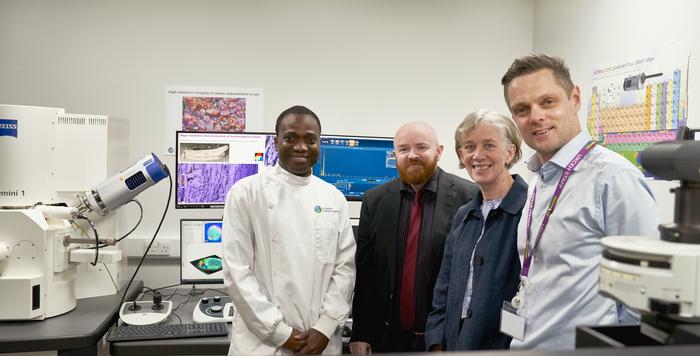New state-of-the-art microscopes will revolutionise UK research into tiny chemical and natural particles as small as one-eightieth of the width of a human hair, and provide vital information about their impact on the environment and human health.

Credit: UKCEH
New state-of-the-art microscopes will revolutionise UK research into tiny chemical and natural particles as small as one-eightieth of the width of a human hair, and provide vital information about their impact on the environment and human health.
The Government’s Chief Scientific Adviser, Professor Dame Angela McLean, opened the new £750,000 UK Centre for Multimodal Correlative Microscopy and Spectroscopy (CoreMiS) on 30 January 2024.
Funded by the Natural Environment Research Council (NERC), it is available for all scientists from the UK and around the world to use.
The strength of CoreMiS over most existing, standalone, laboratory equipment in the UK, is that it has a range of instrumentation capable of electron microscopy, fluorescence microscopy, Raman spectroscopy and X-ray techniques that can be combined for detailed analysis of samples within a single instrument. This enables researchers to align different techniques to provide even greater insights.
CoreMiS can, for example, be used to measure how the chemistry of pollutants in air, water, and soils changes when they enter tissues and cells, so we can better understand their toxic effects. The facility will also help researchers identify the mechanisms of antimicrobial resistance and better understand the biogeochemical processes that govern soil health, nutrient and carbon dynamics.
However, it has a wide range of potential uses, and has already enabled scientists to analyse a 2,000-year-old reed mat found at Pompeii, to investigate why it has survived and whether its chemical composition can provide information on how to make materials more durable to reduce waste and pollution. It has also been used to detect and examine the shape, size and composition of micro- and nanoparticles in drinking water.
Dr Gbotemi Adediran, an emerging contaminants scientist at UKCEH, oversees the operation of CoreMiS. He explains: “This is the first time that environmental researchers have had access to a single facility in the UK that is dedicated to analysis of environmental samples where the various instruments can be targeted at the same sample, and to look inside cells to map distributions of both elements and chemicals”.
“We are excited about the varied ways that it could support, and enhance, environmental science in the UK. Therefore, we are very keen to hear from researchers who believe CoreMiS could help their scientific investigations.”
Professor Dame Angela McLean says: “I was pleased to open Core-MiS and learn more about this excellent facility from the scientists at the UK Centre for Ecology & Hydrology.
“The state-of-the-art instrumentation will transform our understanding of chemical pollutants, analysing how they change as they pass through the environment and their impacts. It is a great example of world-leading science that supports complex challenges affecting the environment and human health.”
If you are a researcher interested in using CoreMIS for your work, email Dr Adediran via [email protected]
There is more information about the facility on the UKCEH website.
– Ends –
Media enquiries
Images of the opening, Core-MiS and objects under the microscopes are available on request. For interviews and further information, please contact Simon Williams, Media Relations Officer at UKCEH. Email [email protected] or call +44 (0)7920 295384.
About the UK Centre for Ecology & Hydrology
The UK Centre for Ecology & Hydrology (UKCEH) is a world-leading centre for excellence in environmental sciences across water, land and air. Our science advances our understanding of environmental exposure and effects of chemicals across water, land and air, producing the evidence that governments and statutory agencies need for ensuring safe and sustainable use. Priority pollutants of interest include radionuclides, pesticides, organic pollutants, toxic metals, nutrients and manufactured nanomaterials and plastics.
The UK Centre for Ecology & Hydrology is a strategic delivery partner for the Natural Environment Research Council.
ceh.ac.uk / @UK_CEH / LinkedIn: UK Centre for Ecology & Hydrology
Subject of Research
Cells




